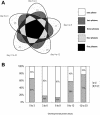Microarray analyses of gene expression during adventitious root development in Pinus contorta
- PMID: 15247392
- PMCID: PMC519068
- DOI: 10.1104/pp.103.032235
Microarray analyses of gene expression during adventitious root development in Pinus contorta
Abstract
In order to investigate the gene expression pattern during adventitious root development, RNA of Pinus contorta hypocotyls, pulse-treated with the auxin indole-3-butyric acid and harvested at distinct developmental time points of root development, was hybridized to microarrays containing 2,178 cDNAs from Pinus taeda. Over the period of observation of root development, the transcript levels of 220 genes changed significantly. During the root initiation phase, genes involved in cell replication and cell wall weakening and a transcript encoding a PINHEAD/ZWILLE-like protein were up-regulated, while genes related to auxin transport, photosynthesis, and cell wall synthesis were down-regulated. In addition, there were changes in transcript abundance of genes related to water stress. During the root meristem formation phase the transcript abundances of genes involved in auxin transport, auxin responsive transcription, and cell wall synthesis, and of a gene encoding a B-box zinc finger-like protein, increased, while those encoding proteins involved in cell wall weakening decreased. Changes of transcript abundance of genes related to water stress during the root meristem formation and root formation phase indicate that the plant roots had become functional in water transport. Simultaneously, genes involved in auxin transport were up-regulated, while genes related to cell wall modification were down-regulated. Finally, during the root elongation phase down-regulation of transcripts encoding proteins involved in cell replication and stress occurred. Based on the observed changes in transcript abundances, we suggest hypotheses about the relative importance of various physiological processes during the auxin-induced development of roots in P. contorta.
Figures



References
-
- Alberts B, Johnson A, Lewis J, Raff M, Roberts K, Walter P (2002) Molecular Biology of the Cell, Ed 4. Garland Science, New York
-
- Benjamini Y, Liu W (1999) A step-down multiple hypotheses testing procedure that controls the false discovery rate under independence. Journal of Statistical Planning and Inference 82: 163–170
-
- Bhalerao RP, Eklöf J, Ljung K, Marchant A, Bennett M, Sandberg G (2002) Shoot-derived auxin is essential for early lateral root emergence in Arabidopsis seedlings. Plant J 29: 325–332 - PubMed
-
- Bray EA, Bailey-Serres J, Weretilnyk E (2000) Responses to abiotic stresses. In BB Buchanan, W Gruissem, RL Jones, eds, Biochemistry and Molecular Biology of Plants. American Society of Plant Biologists, Rockville, MD, pp 1158–1202
Publication types
MeSH terms
Substances
Associated data
- Actions
- Actions
- Actions
- Actions
- Actions
- Actions
- Actions
- Actions
- Actions
- Actions
- Actions
- Actions
- Actions
- Actions
- Actions
- Actions
- Actions
- Actions
- Actions
- Actions
- Actions
- Actions
- Actions
- Actions
- Actions
- Actions
- Actions
- Actions
- Actions
- Actions
- Actions
- Actions
- Actions
- Actions
- Actions
- Actions
- Actions
- Actions
- Actions
- Actions
- Actions
- Actions
- Actions
- Actions
- Actions
- Actions
- Actions
- Actions
- Actions
- Actions
- Actions
- Actions
- Actions
- Actions
- Actions
- Actions
- Actions
- Actions
- Actions
- Actions
- Actions
- Actions
- Actions
- Actions
- Actions
- Actions
- Actions
- Actions
- Actions
- Actions
- Actions
- Actions
- Actions
- Actions
- Actions
- Actions
- Actions
- Actions
- Actions
- Actions
- Actions
- Actions
- Actions
- Actions
- Actions
- Actions
- Actions
- Actions
- Actions
- Actions
- Actions
- Actions
- Actions
- Actions
- Actions
- Actions
- Actions
- Actions
- Actions
- Actions
- Actions
- Actions
- Actions
- Actions
- Actions
- Actions
- Actions
- Actions
- Actions
- Actions
- Actions
- Actions
- Actions
- Actions
- Actions
- Actions
- Actions
- Actions
- Actions
- Actions
- Actions
- Actions
- Actions
- Actions
- Actions
- Actions
- Actions
- Actions
- Actions
- Actions
- Actions
- Actions
- Actions
- Actions
- Actions
- Actions
- Actions
- Actions
- Actions
- Actions
- Actions
- Actions
- Actions
- Actions
- Actions
- Actions
- Actions
- Actions
- Actions
- Actions
- Actions
- Actions
- Actions
- Actions
- Actions
- Actions
- Actions
- Actions
- Actions
- Actions
- Actions
- Actions
- Actions
- Actions
- Actions
- Actions
- Actions
- Actions
- Actions
- Actions
- Actions
- Actions
- Actions
- Actions
- Actions
- Actions
- Actions
- Actions
- Actions
- Actions
- Actions
- Actions
- Actions
- Actions
- Actions
- Actions
- Actions
- Actions
- Actions
- Actions
- Actions
- Actions
- Actions
- Actions
- Actions
- Actions
- Actions
- Actions
- Actions
- Actions
- Actions
- Actions
- Actions
- Actions
- Actions
- Actions
- Actions
- Actions
- Actions
- Actions
- Actions
- Actions
LinkOut - more resources
Full Text Sources
Molecular Biology Databases

